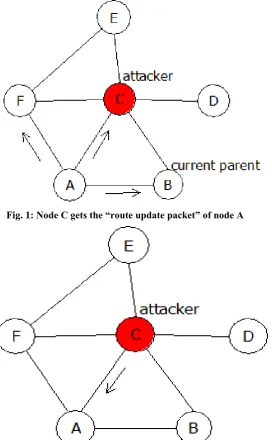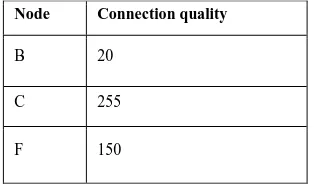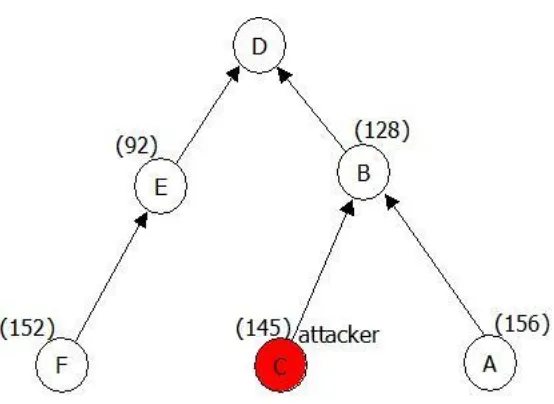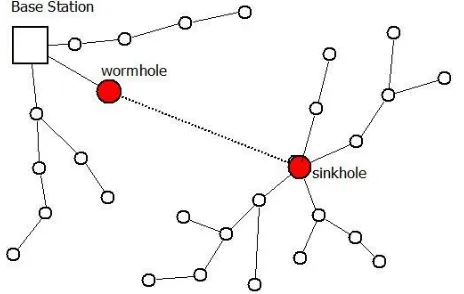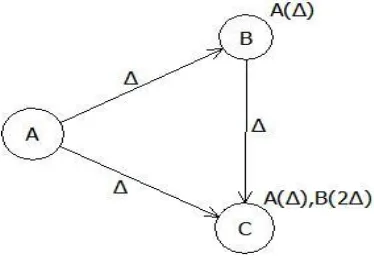1047 | P a g e
GENERATION MECHANISMS OF SINKHOLE
ATTACK IN ROUTING PROTOCOLS OF WIRELESS
SENSOR NETWORK
Amit kumar jangid
1, Dr. Nonita sharma
2, Ankur bohora
31,2,3
Department of Computer Science & Engineering, National Institute of Technology Delhi, (India)
ABSTRACT
The proposed research work is an attempt to demonstrate the intrusion detection system for sinkhole attack in
wireless sensor network. First, we choose one of the most vulnerable attacks in the wireless sensor network that
is sinkhole attack to study in details. Further, we reviewed all the existing routing protocol where the sinkhole
attack can be generated and also described, how it can be incepted. Finally, we studied the survey paper that
highlights the routing protocols prone to sinkhole attack.
Keywords: A Laptop Class Adversary; Gradient; Intrusion Detection System; Link Quality
Estimates; Routing Protocol; Sinkhole Attack; Vulnerable;
I. INTRODUCTION
Wireless sensor network(WSN) is a collection of sensor nodes which are spatially distributed in the environment
to monitor physical conditions such as sound, weight, temperature, etc. and to helpfully pass their information to
the central location(Base station) through the network by using many well-known routing techniques. Base
station is a computation center where all the computation has to be done. In WSN traffic flows in the direction
ofthe base station through one or more sink nodes. WSN focuses mainly on sensing data, transferring the
sensing data to the base station, which can manage all the communication between nodes. The potential
applications of sensor network includes air traffic control, monitoring weather, traffic monitoring, automated
and smart home, video surveillance and robot control, etc.
The predominant characteristics of WSN are distributed and wireless in nature. It also has many demanding
constraints in the node battery power prevention. These imperatives make an extensive number of vulnerabilities
that attacker can adventure to access the network [9]. Securing sensor arrange against these dangers is a testing
research area. In WSN many routing protocols are not aware of these security issues and are not composed
having security dangers as a main priority. So attacker need not put some extra effort to exploit the network and
easily they can gain access to the network. So it is imperative to study the realistic routing protocols of WSN
and to get to know how the attacker can essentially perform the attack.
The network layer is in charge of steering the information, provided by the transport layer. Many routing
protocols are used to transfer the data or packets in the network between nodes. The network layer is vulnerable
1048 | P a g e
Sybil attack, etc. Sinkhole attack is the most vulnerable attack in the network layer and intruder can easilyexploit it [5]. In this manuscript, various sinkhole attacks are studied in detail.
In a sinkhole attack [5], the whole traffic of the network is attracted by the compromised node, which is
responsible for the attack in the network. Compromised node cooperatively participates and is predominantly
responsible for launching a sinkhole attack in the network. The traffic gets attracted by many methods like
announcing a low hop count to the base station or an excellent connection to the base station and much more.
The compromised node can alter the data packet, loss the data packet and it can also forward the data packet to
the attacker. Sinkhole attack may be responsible for launching further attacks like select forwarding attack.
At long last, this paper researches a standout amongst the most vulnerable routing attacks that is sinkhole attack
from assailant’s perspective. So from this, we get to know the weakness of the routing protocols of WSN and
trusting that this will prompt to a superior consciousness of era of the sinkhole attack. Hence, the study will also
drive the improvement in routing protocols to enhance resistance to routing sinkhole attack.
There are many routing protocols those are vulnerable to sinkhole attack like MintRoute protocol, MultiHop
LQI protocol, Tiny AODV protocol, TinyOS beaconing routing protocol, Directed diffusion(DD) routing
protocol, and Rumor routing protocol, etc. Further, we will study these protocols in detail like their operation
and the point of vulnerability to these attacks.
II. SINKHOLE ATTACK IN VARIOUS ROUTING PROTOCOL
2.1 MintRoute routing protocol [3],[4]
It is a new standard routing protocol for TinyOS.It’s routing decisions mainly on link quality estimates rather
than minimum hop count, to choose the best route to send a packet to the base station. Link quality estimation is
calculated with the help of packet error rate. Each node appraises the connection nature of its neighbors in view
of the loss ofpackets, which are received from their corresponding neighbor. Periodically, each node broadcast
all these estimates for each neighbor in the form of packets, which is known as “route update packets”. Every
node keeps a neighbor table which is updated by the assistance of “route update packet”. The neighbor table
incorporates id’s of every neighboring node and their comparing link cost. The node picks it’s “parent node” to
be the one with best connection quality in the neighbor table. On the off chance that two nodes have same
connection quality then the minimum hop distance of each neighbor to the base station is thought about in
picking the parent.
On the off chance that either the connection nature of at least one nodes gets to be distinctly 75% superior to the
connection nature of the present parent or the connection nature of the present parent drops beneath 25 in total
qualities, then the parent changing mechanism is activated, and the node with the most noteworthy connection
quality turns into the new parent. In the event that two nodes have same connection quality then which one have
least hop count to the base station will turn into a parent. In this protocol, the routing metric is Link estimates of
links.
Attack: The sinkhole attack is launched with the help of compromised node. Compromised node removes
current parent of nodes and makes sinkhole node as a new parent of nodes. The compromised node can launches
1049 | P a g e
1) Publicize an attractive connection quality for itself into the network.2) Make other nodes appear as though they have more awful connection quality than itself.
This protocol doesn’t permit the nodes to change their parents as often as possible, so the publicizing a high
connection quality to the other node is not a smart thought. For that try another way to launching a sinkhole
node that makes current parent link quality unsubstantial, so from this the parent changing algorithm will start in
their children nodes. The new parent turns into the sinkhole node by modified the connection quality estimates
sent by the parent nodes inside their “route update packet”. The intruder will read the “route update packets”
from its neighbor, modify them and replays them mimicking the original sender.
Fig. 1: Node C gets the “route update packet” of node A
1050 | P a g e
Table 1: Neighbor table of Node ATable 2: Updated neighbor table of node A
First node A sends route update packet to node F, C, B (Fig. 1). Here the attacker is node C, and the current
parent is node B (Fig. 1). Node C has sent its “route update packet” promoting a fake connection quality (most esteem 255), however this is insufficient to roll out node A to modify its parent (Table 1). In this way, when
node C gets the “route update packet” of node A than it adjust the connection nature of node B to low esteem
and sent back to node A. The node A again re-estimates the connection nature of all neighbor nodes and refresh
the neighbor table (Table 2) correspondingly and furthermore apply parent changing algorithm. Since the
connection nature of node B is bellow 25 (Table 2) so node B is ignored by node A and node C is picked as a
new parent.
2.2
MultiHop LQI routing protocol [3],[6]
In this protocol, the connection quality is figured by the assistance of their hardware(Radio chip). Every node
intermittently communicate a message (Beacon message) to the network, and the collectors separate the
connection quality given by radio chip. This link quality is input to the function, and the function output is the
cost of the corresponding link. Here, the link quality of the link is inversely proportional to the cost of the link.
Beacon message incorporates sender’s present parent and the cost of the entire way to the base station (way
cost). We can represent the cost of node A to node B as follows
COSTAB: cost estimation of node A that is connected to the node B.
Computation of path cost for a node B that has parent D is as per the following:
COSTB = COSTBD + COSTD
Node A read beacon message and stores the incentive in its table. It likewise ascertain the way cost to the goal
as depicted previously.
Attack: There are mainly two ways to launch a sinkhole attack by an attacker
Way1: Promote a low way cost with its parent.
Way2: Make other nodes appear as though they have more regrettable way costs than itself. Node Connection quality
B 170
C 255
F 150
Node Connection quality
B 20
C 255
1051 | P a g e
Fig. 3: Multi hop LQI routing protocolWay1: The way cost that relates to the maximum LQI is 15. Node C reduces its path cost 145 to 15 (Fig. 4).
Therefore node A, E, F changes their parent to node C (result of way1 attack) and the parent changing
mechanism is also started at the parent (node B) of the attacker (node C) (Fig. 4).
Fig. 4: Way 1 of attack
Way2: Attacker (node C) alter the path cost of node E is very high let’s say, 1000. So from this node E’s child
(node F) estimates the path cost and realizes that it have very worse path cost in the way of node E (Fig. 5). So
node F starts parent changing mechanism and choose node C (attacker) as its new parent (Fig. 5). On the off
chance that the attacker (node C) takes a similar procedure for every hub, then it will able to attract all the
1052 | P a g e
Fig. 5: Way 2 of attack2.3
Tinoy AODV protocol [4],[6],[7]
TinyAODV is same as AODV in MANET, but TinyAODV is very lighter routing protocol compare to AODV
in MANET [9]. AODV stands for ad-hoc on demand vector. In this protocol routing metric is the number of
hopes to the base station.
When one of nodes needs to convey or needs to make an impression on the base station, first it need to make a
way from source to destination so for that it sends RREQ (Route Request) packet to its neighbors. From that
point onward, the neighbor node which is near the destination will send RREP (Route Reply) packet to the
source node. At long last, the source node gets RREP packet from the neighbor and chooses one node with a
minimum number of hop count to the destination.
Attack: The sinkhole attack can be generated by the help of compromised node. Compromised node will
send RREP packet to the source node and inform to source node that it has a minimum number of hop count to
the destination. Next, the source node decides to send packet to sinkhole node or compromised node.
Compromised node performs the same technique to all its neighbors and attract as much traffic as it can.
Fig. 6: Sinkhole attack in Tinoy AODV protocol
In Fig. 6 node A send routes request to node B, C, M. Node M is compromised node. Node B and C are sending
packets to node D which is 2 hop distance far from the destination node. Compromised node M, which is 2 hop
count far from destination node changes its 2 hop count to 1 hop count and send this updated information to
node A in the form of RREP packet. Node A then rejects the path to the destination through node B, C and
1053 | P a g e
2.4
TinyOS beaconing [1],[2],[5]
This protocol constructs a spanning tree as the base station is the parent for all nodes. Occasionally base station
communicate the "routing update packet" to its neighbors, and the neighbor nodes will communicate to its
neighbors. This process is keep going on recursively until the routing update packet of the base station will not
spread in the entire network. All packets received or produced by nodes are sent to their parent until they don't
reach at the base station.
The straight forwardness of this protocol makes it defenseless to the sinkhole attack since routing updates are
not verified and not authenticated as well. It is conceivable that any node can guarantee that it is the base station
and can turn into the parent of all nodes in the network. Authenticated routing updates may tackle this issue, yet
at the same time sinkhole attack can be created.
Fig. 7: A laptop class adversary utilizing a wormhole to make a sinkhole
Attack: In this protocol, the sinkhole attack is produced by the assistance of wormhole attack (Fig. 7). So for
that, adversary first make a wormhole between two colliding laptop class nodes. One laptop class is close to
base station, and other is close to focused attack region (Fig. 7). The primary node send authenticated routing
update to the second node that is situated in focused attack zone through the wormhole. Further, the second node
broadcast this packet to the focused attack zone. The second node creates a large routing sub tree in the focused
attack zone with itself as the root (sinkhole) of that tree.
2.5
Directed Diffusion [1],[2],[5],[7]
This protocol is mainly used for distributed activates. It has two primary elements which are gradients and
interest. Interest is a task description to define sensor events. It has a list of attributes including type, region,
rate, span, and time stamp. Type is utilized to distinguish what kind of information is detected. The region is
utilized to decide the network part from which information is drawn. The rate is utilized to distinguish, how
frequently information is sent in the network. Span is utilized to decide, to what extent the interest ought to be
dynamic. The time stamp is utilized to revive the interest. Each interest section has a few gradients to each
neighbor node. Every gradient additionally has an arrangement of characteristics including a node identity (to
whom the information needs to forward), data rate (how frequently the information is sent) and span (to
1054 | P a g e
The fundamental work of this protocol to diffuse the interest in the network, setting up the gradients (slopes),sending information and path reinforcement. Every node that gets the interest will build a gradient towards the
inception node. Gradient contains attribute value and direction.
Fig. 8: Gradient setup in directed diffusion routing protocol
At the point when node B gets interest from node A, it incorporates A (∆) as its gradient (Fig. 8). At the point
when node C gets interest from node A through node B, it incorporates B (2∆) as its gradient (Fig. 8). At the
point when the information coordinates the interest (event), way data streams to the base station at a low rate
then the base station recursively reinforces at least one neighbors to answer at a higher information rate.
In this protocol eavesdrop of the interest is an easy task. When adversary receives an interest from the network,
it can only reply that interest with himself listed as the base station. The response is sent to the network and also
received by the adversary.
Attack: a laptop class adversary can create a wormhole between one node near to base station and another
node in the targeted attack area. The interest publicized by the base station and tunnels through the wormhole to
the focused attack area. So the information streams far from the base station and towards coming about sinkhole.
2.6
Rumor routing [2],[5]
Rumor routing is a variation of directed diffusion routing protocol. In this protocol flooding is not used in the
entire network to match the information, so we can say it is energy efficient routing protocol compare to
Directed Diffusion routing protocol. This protocol is described by events, queries, and agents. The event is a
marvel happening in a settled region of the network. Queries are requested for information to the nodes in the
network. Agents are used to create paths leading to events. Agents are long-lived packet in the network. Every
node in the way contains a list of its neighbors and event table. Event table incorporates name of the event, hop
distance to an event and next node in the way towards the event. In this convention, any node can produce the
query and afterward send it arbitrarily in the network to discover the way. The query keeps going until it finds
the way or it’s TTL (time to live) get to be distinctly zero.
At the point when a source node watches an event, then it creates an agent. The agent is broadcasted in the entire
network to create the path leading to an event. Agent packet incorporates a list of all possible events, next
possible path to those events, the hop distance of that path, a list of nodes that are previously visited and TTL
field. If the base station wants to propagate query in the network so first, it creates an agent and then broadcast it
1055 | P a g e
Attack: As explain above, the agents carry very sensitive information. So adversary can remove eventinformation carried by the agent and forward to the attacker. Mote class adversaries can create sinkhole by
extending tendrils in all the directions. It produces tendrils by forwarding multiple copies of a received agent.
III. CONCLUSION
We have illustrated that some proposed routing protocols are vulnerable to sinkhole attack in the WSN. Further,
we proposed the generation mechanism of sinkhole attack in various existing routing protocols of WSN. So
these routing protocols are unreliable and unsecure against sinkhole attack. Finally, we leave it as an open
problem to design a sensor network routing protocols that satisfies our proposed security goals and possess
prevention measures against sinkhole attack.
REFERENCES
[1] Karlof, Chris, and David Wagner. "Secure routing in wireless sensor networks: Attacks and
countermeasures." Ad hoc networks 1.2 (2003): 293-315.
[2] Sadeghi, Mohammad, et al. "Security analysis of routing protocols in wireless sensor networks."
International Journal of Computer Science Issues 9.1 (2012): 465-472.
[3] Krontiris, Ioannis, Thanassis Giannetsos, and Tassos Dimitriou. "Launching a sinkhole attack in wireless
sensor networks; the intruder side." Networking and Communications, 2008. WIMOB'08. IEEE
International Conference on Wireless and Mobile Computing,. IEEE, 2008.
[4] Kibirige, George W., and Camilius Sanga. "A Survey on Detection of Sinkhole Attack in Wireless Sensor
Network." arXiv preprint arXiv:1505.01941 (2015).
[5] Qureshi, Muhammad Danish, et al. "Analysis of Various Attacks in Routing Protocols for Wireless Sensor
Network."
[6] John, Celia, and Charu Wahi. "Security Analysis of Routing Protocols for Wireless Sensor Networks."
International Journal of Applied Engineering Research 11.6 (2016): 4235-4242.
[7] Hasan, Mohammed Zaki, Hussain Al-Rizzo, and Fadi Al-Turjman. "A Survey on Multipath Routing
Protocols for QoS Assurances in Real-Time Wireless Multimedia Sensor Networks." IEEE
Communications Surveys & Tutorials (2017).
[8] Shahzad, Furrakh, Maruf Pasha, and Arslan Ahmad. "A Survey of Active Attacks on Wireless Sensor
Networks and their Countermeasures." arXiv preprint arXiv:1702.07136 (2017).
[9] Nazir, Muhammad Kashif, Rameez U. Rehman, and Atif Nazir. "A Novel Review on Security and Routing
Protocols in MANET." Communications and Network 8.04 (2016): 205.
[10] L. Zhou and 2. Haas, "Securing ad hoc networks:' IEEE Newark Magazine, vol. 13. no. 6.
November/December 1999.
[11] C. lntanagonwiwat, R. Govindan, and U. Estrin. "Direcled diffusion: A sealable and robust wmunication
paradigm for sensor networks," in Proceedings of the Sixth Annul lntemtionnl Confit" on Mobile
Computing and Neworks (MobiCOU 'XJJ, August 2000.
1056 | P a g e
[13] J. Paul Walters, Z. Liang, W. Shi, and V. Chaudhary, Wireless Sensor Network Security: A Survey,Department of Computer Science Wayne State University.
[14] D. Braginsky and D. Estrin, Rumour routing algorithm for sensor networks, in First ACM International
Workshop on Wireless Sensor Networks and Applications, 2002.
[15] Abhishek Pandey and R.C. Tripathi. (2010). A Survey on Wireless Sensor Networks Security, International
Journal of Computer Applications (0975 – 8887) Volume 3 – No.2.
[16] Choi, G. B., Cho, J. E., Kim,H. J., Hong, S. C. and Kim, H. J. (2008).A sinkhole attack detection
mechanism for LQI based mesh routing in WSN. In ICOIN (pp.1-5).
[17] David Martins and Hervé Guyennet. (2010) Wireless Sensor Network Attacks and Security Mechanisms: A
Short Survey, In Network-Based Information Systems (NBiS), 2010 13th International Conference on (pp.
313-320). IEEE.
[18] Ngai, E., Liu, J. and Lyu, M. (2006). On intruder detection for Sinkhole attack in Wireless Sensor Network.
In Communications, 2006. ICC’06.IEEE International Conference on (Vol. 8, pp.3383-3389). IEEE.
[19] John Paul Walters et al, A Survey: ―Wireless Sensor Network Security‖, Department f Computer Science
Wayne State University, August 2008.
[20] K Lakshmi, S Manju Priya, A Jeevarathinam, K. Rama, K. Thilagam, “ Modified AODV Protocol against
Blackhole attacks in MANET”, International Journal of Engineering and Technology.
[21] Seryvuth Tan, Keecheong Kim, “ Secure Route Discovery for Preventing Blackhole Attacks on AODV
Based MANETs” IEEE International Conference on Telecommunication, 2013.
[22] Dutta, C.B. ; Dept. of CSE, Univ. of Kalyani, Kalyani, India ; Biswas, U. A novel blackhole attack for
multipath AODV and its mitigation, Recent Advances and Innovations in Engineering (ICRAIE), 2014.
[23] Khan, Shafiullah, et al. "Passive security threats and consequences in IEEE 802.11 wireless mesh
networks." 2; 3 (2008).
[24] F. Akyildiz et al., “A Survey on Sensor Networks,” IEEE Commun. Mag., vol. 40, no. 8, Aug. 2002, pp.
102–14.
[25] Garg, N., Aswal, K. and Dobhal, D.C. (2012) A Review of Routing Protocols in Mobile Ad Hoc Networks.
International Journal of Information Technology, 5, 177-180.
[26] de Morais Cordeiro, C. and Agrawal, D.P. (2002) Mobile Ad Hoc Networking.
[27] C. Jisul and K. Keecheon, "EADD: Energy aware directed diffusion for wireless sensor networks,"
International Symposium on Parallel and Distributed Processing with Applications (ISPA) , pp. 779-783,
